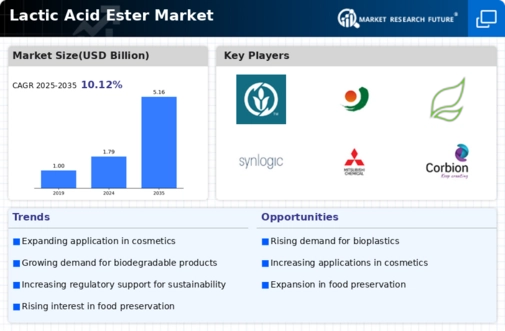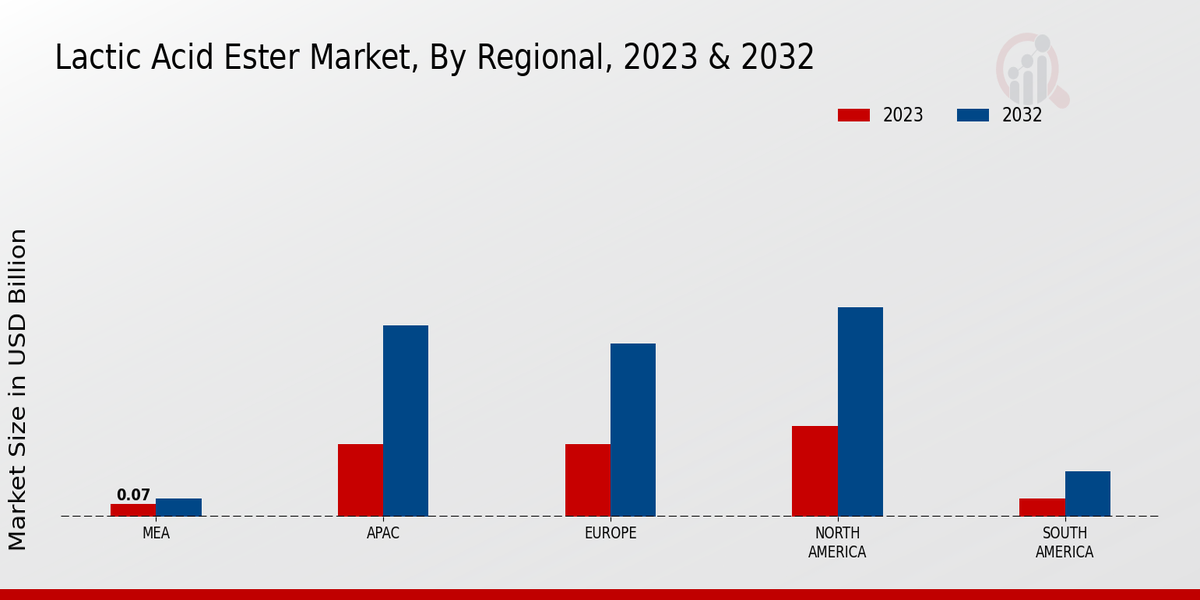Market Growth Projections
The Global Lactic Acid Ester Market Industry is projected to experience substantial growth, with estimates indicating a rise from 1.79 USD Billion in 2024 to 5.16 USD Billion by 2035. This growth trajectory reflects a compound annual growth rate (CAGR) of 10.11% from 2025 to 2035, highlighting the increasing adoption of lactic acid esters across various applications. The market's expansion is driven by factors such as rising demand for biodegradable materials, technological advancements, and growing consumer awareness of health benefits. These projections suggest a robust future for the industry, positioning lactic acid esters as a key player in the global market.
Growing Awareness of Health Benefits
The Global Lactic Acid Ester Market Industry is benefiting from a growing awareness of the health benefits associated with lactic acid esters. These compounds are recognized for their potential to improve gut health and support metabolic functions, leading to increased interest from both consumers and manufacturers in the health and wellness sector. As dietary supplements and functional foods gain popularity, lactic acid esters are being incorporated into various formulations, catering to health-conscious consumers. This trend is expected to bolster the market, as the demand for products that promote overall well-being continues to rise.
Rising Demand for Biodegradable Plastics
The Global Lactic Acid Ester Market Industry is experiencing a notable increase in demand for biodegradable plastics, driven by growing environmental concerns and regulatory pressures. As consumers and manufacturers alike seek sustainable alternatives to conventional plastics, lactic acid esters, derived from renewable resources, are gaining traction. This shift is reflected in the projected market value, which is expected to reach 1.79 USD Billion in 2024 and further expand to 5.16 USD Billion by 2035. The compound annual growth rate (CAGR) of 10.11% from 2025 to 2035 underscores the potential for lactic acid esters to play a pivotal role in the transition towards eco-friendly materials.
Regulatory Support for Sustainable Practices
Regulatory support for sustainable practices is a significant driver for the Global Lactic Acid Ester Market Industry. Governments worldwide are implementing policies that encourage the use of biodegradable materials and the reduction of plastic waste. These regulations create a favorable environment for lactic acid esters, which are derived from renewable resources and offer an eco-friendly alternative to traditional petrochemical-based products. As regulations become more stringent, manufacturers are likely to increase their investments in lactic acid ester production, further propelling market growth and contributing to a more sustainable future.
Technological Advancements in Production Processes
Technological advancements in the production processes of lactic acid esters are driving efficiency and cost-effectiveness within the Global Lactic Acid Ester Market Industry. Innovations in fermentation technology and catalytic processes are enabling manufacturers to produce lactic acid esters with higher yields and lower energy consumption. These improvements not only enhance the economic viability of lactic acid esters but also align with sustainability goals by reducing waste and emissions. As production methods continue to evolve, the industry is likely to see increased adoption of lactic acid esters across various sectors, further solidifying their market position.
Expanding Applications in Food and Beverage Industry
The Global Lactic Acid Ester Market Industry is witnessing an expansion in applications within the food and beverage sector. Lactic acid esters are increasingly utilized as emulsifiers, stabilizers, and flavoring agents, enhancing product quality and shelf life. This trend is particularly evident in the production of dairy products, baked goods, and beverages, where the demand for natural ingredients is rising. The market's growth trajectory is supported by consumer preferences for clean-label products, which are perceived as healthier options. As a result, the integration of lactic acid esters into food formulations is likely to contribute significantly to the industry's overall growth.











